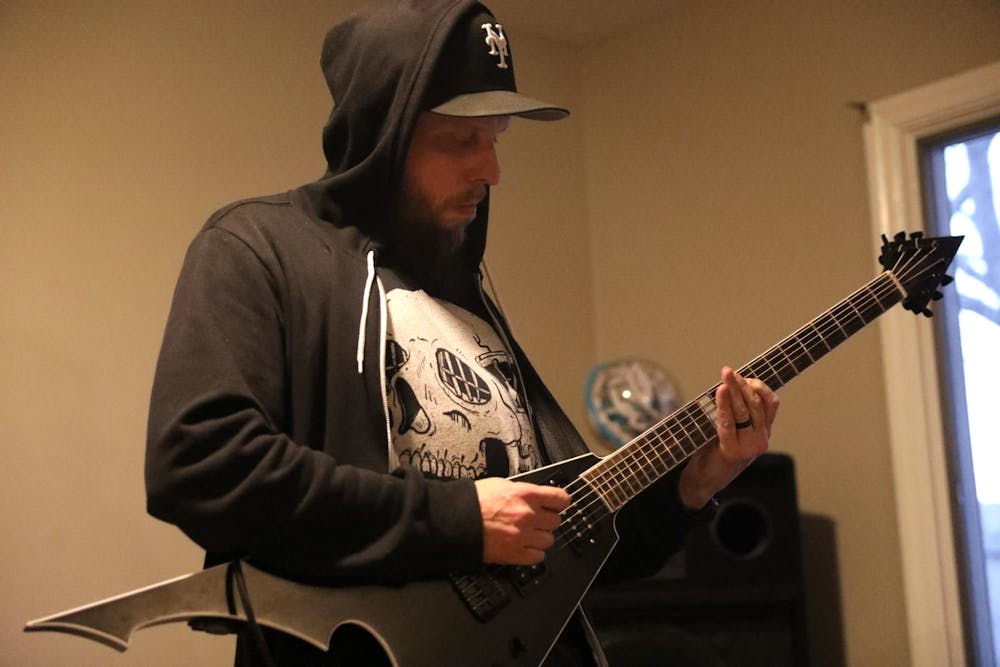By: Mesgana Waiss
The views of the sources used in this story do not reflect the views of the magazine.
Content Warning: This story contains mentions of suicide.
In the spring of 1931, a small Indiana town became the birthplace of Jim Jones, who claimed to be the next Messiah primed to take believers away from this earth.
During the mid-1950s, he founded the People’s Temple in Indianapolis. The self-proclaimed “enlightened one” had his eyes set on an oppression-less paradise.
He created Jonestown, a commune located in Guyana.
On Nov. 18, 1978, he convinced more than 900 of his followers to join him in drinking cyanide-laced “Kool-Aid” to enter salvation. It remains the largest murder-suicide in history.
According to the APA Dictionary of Psychology, a cult is a religious or quasi-religious group with unusual or atypical beliefs, which secludes its members from the outside world and has an authoritarian structure. It adds that cults tend to be highly cohesive, well-organized, secretive, and hostile to nonmembers.
Cults are not only religious in nature. According to the Foundation for Economic Education, they are formed around an individual, an object, an animal, or a concept.
Nathaneal Snow, an associate professor of economics at Ball State University with research expertise in informal social groups, says most cults have distinct ideologies and methods of manipulation and abuse. A cult’s lifecycle is often marked by four stages: recruitment, indoctrination, isolation, and sometimes dissolution.
Snow says cults have the following three requirements for their members: sacrifice, stigma, and trust.
He says all cults eventually face tension between leaders and their members, and tension often leads to self-destructive techniques that cause the organizations to collapse.
In this age, Americans find themselves lonelier than ever, according to GCF Global. This may be a reason people turn to cults.
“It’s a very human kind of thing. We desire more than anything else to belong, and we desperately want to trust people,” Snow says.
Indiana has an extensive history of alternative communities and cults, such as the 1814 religious group Harmonist. According to the Indiana Archives and Records Administration, they were known for their beliefs in celibacy, communal living, and the Second Coming of Christ.
However, while some organizations are not nationally recognized as cults, some of their members have experienced what they felt were cult-like tendencies.
The reality of rush
Rush week has re-emerged on campuses across the country since fraternities and sororities put recruitment week on hold during the
COVID-19 pandemic.
While some have perfectly positive rush experiences, 22-year-old Kailee Fowler says rush was a stressful time, especially for active members who must put in long hours during selection sessions and bid day.
According to the Office of Student Life, Ball State is home to 30 sororities and fraternities.
“They make it look so fun. You don’t realize it until you’re in it, you are a part of that advertising,” she says. “During my first recruitment, I almost dropped because I was so overwhelmed by
the process.”
Kailee has two words to describe her sisterhood: toxic and expensive.
During her time spent in the sorority, she did not encounter hazing. Instead, she says everyone was volatile toward each other. She says it was Wondery’s “Morbid,” a true crime podcast, that helped her reflect on what she says is the cult-like tendencies within her sorority.
“Being in a sorority a lot of people … will be like, ‘Do you know you’re in a cult?’ And the whole time you’re like, no, that’s not true. And then you get out, and you’re like, that’s kind of a cult,” Kailee says.
She says a strict dress code was enforced for events and a few mandatory chapter meetings. For example, they were to wear white for initiations and pinning ceremonies.
Kailee says that for formal chat, which was on the first Sunday of every month, members were required to wear clothes that covered their midriff and cleavage. All dress and skirt lengths were to be finger-tip length.
“You’re not allowed to smoke, have sex, drink, or anything for the week before initiation,” Kailee says.
This, Kailee adds, was so that the girls would stay “pure.”
She was the social chair of her sorority, which required her to plan all the organization’s social events.
Kailee also disliked the costliness of monthly dues, which were about $100.
“We were not allowed to talk about the money of the sorority during recruitment,” Kailee says. “We could not tell them about paying dues or any of that.”
She left Ball State and the sorority around the same time during her junior year. Kailee estimates she spent close to $5,000 on dues and activities during her three years in the organization.
Kailee offers this advice to students who may want to rush a sorority or fraternity.
“My biggest piece of advice would be during recruitment,” she says. “Don’t care what they think about you … it is more important if you like the sorority. You need to find where you belong. I do think there were other sororities that I could have been happier in.”
Trauma in the pews
The Church of Jesus Christ of Latter-Day Saints (LDS), commonly called “Mormons,” is a religious movement founded in the 19th century by Joseph Smith Jr. He was an American religious leader who claimed to have received revelations from God to translate the Book of Mormon.
According to the church’s April 2023 report, the church has around 17 million members worldwide. Former Ball State student Ashton Clark and his family were once represented in this number.
Ashton was born to a multi-generational Mormon family. He spent most of his life in a church pew and was told he would become a missionary. Each day before school, he attended seminary for an hour. On Wednesdays and some Saturdays, he attended activity nights at church.
But at age 14, Ashton had a change of heart. He began to question his faith and
its teachings.
“I was kind of thinking for myself for once in my life,” he says.
He and his mother consumed “anti-church” material aimed at Mormon believers on the fence. It was then that Ashton discovered the church’s racial history against Black people.
Smith Jr. and his successor Brigham Young taught their congregation that dark skin was a curse from God using the biblical story of Cain and Abel. An article in the “Journal of Mormon History” explains how this racial narrative was entrenched in Mormon doctrine for many years like Smith Jr.’s 1842 “Book of Abraham.” This contributed to discriminatory practices and attitudes within the faith.
According to the Century of Black Mormons, the one-drop policy prevented anyone with Black ancestry from the LDS priesthood and admission into the temples. This decision was not reversed until 1978.
In 2013, the church published an essay, “Race and the Priesthood,” which denounced its prior racist beliefs and has since worked to improve race relations. They formed a partnership with the NAACP and committed $3 million to fund scholarships for Black students.
According to the Pew Research Center, today Black people make up 1% of the LDS church.
Ashton says he would vehemently debate these findings with his family and friends in the church, but he was told that this was “God’s plan.”
“When you start debating, it’s not a debate. It’s an insult to who they are as a person because their identity is tied to the church,” Ashton says. “And if they’re wrong, their identities are wrong, so they will defend that above anything.”
The native of Columbus, Indiana, says he felt he was in a cult based on what he calls the church’s indoctrination process. The LDS church has emphasized its core beliefs, practices, and community engagement in response to cult allegations.
Ashton officially left the church at 18.
A literal cult following
Is there a way to reframe a cult decades after its subsequent tragic ending? Muncie native and Ball State alumnus, Tommy Miller, thinks so.
He originally studied religion at Ball State before switching to music education because he was enamored by the diverse ideologies.
“I just remember having my mind blown at the number of different religions in Muncie,” Tommy says. “I was like, ‘Oh my God. There’s so many different kinds of people here.’”
He started his band, Void King, nine years ago with his little brother, a best friend of 40 years, and a local musician. The band has toured both Europe and the United States.
Guitarist Tommy Miller playing his guitar while practicing with his group “Void King” in their home March 21, 2024 in Muncie, Ind. Paola Fernandez Jimenez, Ball Bearings
Muncie is the home base for the making of Void King’s music.
Void King carries with them a philosophy. Tommy says they exist in the sonic landscape akin to Black Sabbath but louder. The robust vocals on “Skull Junkie” from their debut album, “There Is Nothing,” bleeds into an aggressive guitar solo and elaborate drum beats.
The four rockstars elevated their performance art with two words — Heaven’s Gate.
Heaven’s Gate was a cult founded in the 1970s by “The Two,” born Marshall Applewhite and Bonnie Lu Nettles. The cult regained notoriety in March 1997 when 39 of its members committed mass suicide in California.
“It has always intrigued me that you can listen to one guy talk and alter everything about your life in such a way that you end up killing yourself over it,” he says.
At the beginning of the band’s set, they used to walk out to a minute of Applewhite’s three-hour-long farewell recording. Tommy says it set a tone to progress their stage show.
Void King strives to attain a “cult charisma.” This fascination led the bandmates to each buy a pair of now-discontinued Nike Millenniums. These shoes were found on the cultists’ corpses as a part of their black uniform.
Tommy says he and the others want to be purposeful and committed to this charisma, but he says he would never fall for the illusion of a cult.
He has researched many cults and extends a level of empathy to those who are caught up in the hype and mystique. He says he is remiss to use the adjective “crazy” because the people who followed Heaven’s Gate, the People’s Temple, and other cults just wanted to belong.
Three of the four band members were raised in religious households. During Void King’s live performances, the singer sings behind a pulpit from the church he attended in his youth.
Tommy is unsure if the band will deviate from the Heaven’s Gate source text, but he says they hope to continue to build a cult fanbase of listeners.





